Mobile living for ultimate freedom
 I have been playing around with the idea of having a vehicle as a permanent home, to be able to tour around and explore the world as economically and independent as possible.
I have been playing around with the idea of having a vehicle as a permanent home, to be able to tour around and explore the world as economically and independent as possible.
Here are the criteria for the solution:
- Simple technical solutions that are easy to repair.
- Truly independent, with no need to visit hotels, bath rooms or restaurants.
- Economical to operate over great distances.
- Safe to sleep in at night with no worries about intruders.
- Easy to cross country borders without the hassle of paperwork.
The solution is a solar/muscle powered over-sized bicycle, which has foldable parts so it can be reconfigured in different modes.
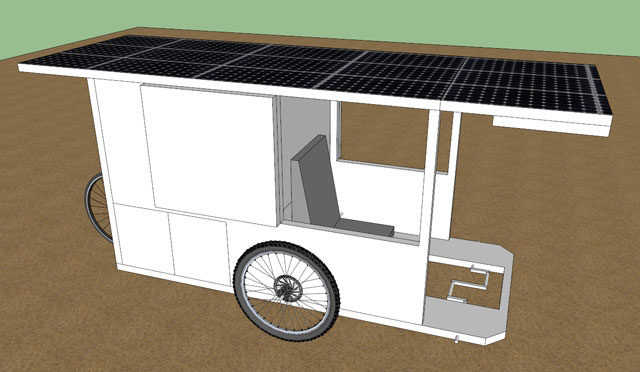
Above: The bicycle in riding mode. The main box is 2.15 m long and 1.10 m wide. Height over ground is 1.55 m. Overall length/width is 3.50/1.35 m.
The vehicle frame is built from aluminum bars to make it light weight and maintenance free. The panels are a sandwich construction with aluminum sheets on the outside, 50 mm Styrofoam in the middle and thin aluminum sheets (or plastic sheets) on the inside. This is for added strength, thermal insulation, and sound insulation. The frame and panels are riveted and glued together for strong and water proof seals.
The front roof and side panels are hinged to be foldable into different configurations.
Design features
- Low center of gravity so it doesn't tip over easy.
- A slow moving vehicle, so no suspension needed.
- As small and light weight as possible so it is not too hard to ride.
- Classified as a bicycle, not as a vehicle that requires registration, for easy pass through borders and no road tax or insurance.
- All sides are metal and can be locked, so it is safe to leave parked somewhere, and to sleep in at night.
- Styrofoam protects against heat and cold, and the vehicle is rain proof.
- Storage area has enough space to carry a basic set of items.
- Roof protects from the sun and rain.
Weaknesses:
- Seated low, with poor overview in traffic.
- Solar panels are exposed to vandalism.
- Not an aerodynamic shape that can be hard to ride in strong wind.
Configurations
Below: All panels are folded down and locked, wheels have parking breaks applied. Its is now safe to leave the bike unattended, or to sleep inside.
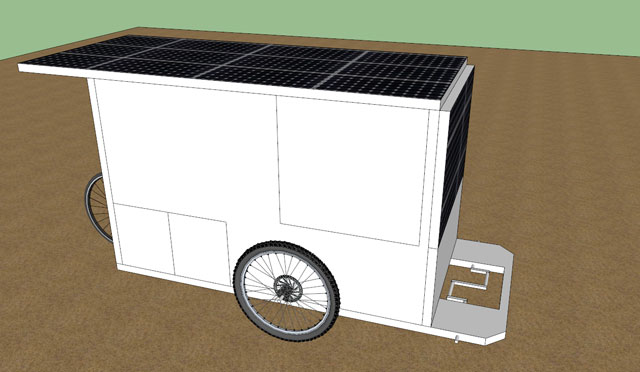
Below: In this view you can see how the center wall is folded forward to make a bed.
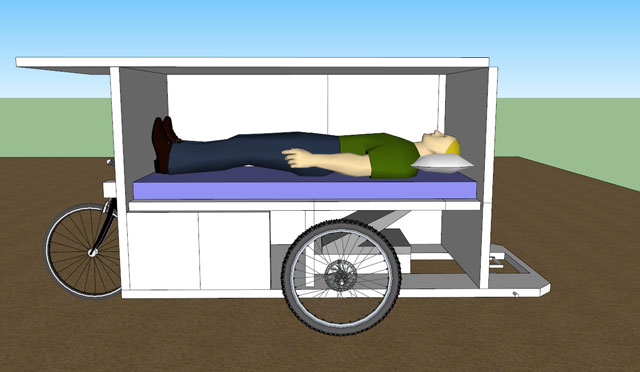
Below: The same view in riding mode. The air mattress (not shown) is folded in half inside the compartment.
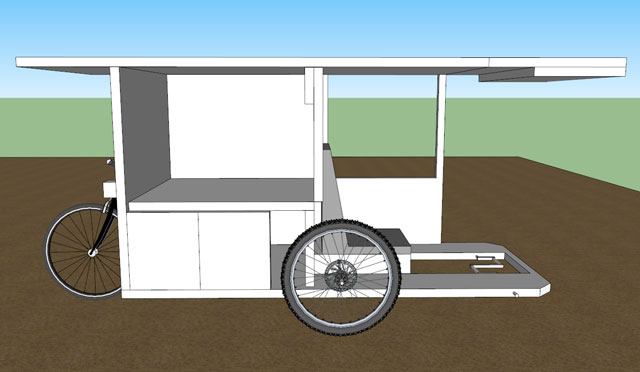
Below: The storage compartment is open to give access to food and tools, and the side panel is folded down to become a table. A lightweight fabric on an aluminum frame forms a roof that shades the outside area (not shown).
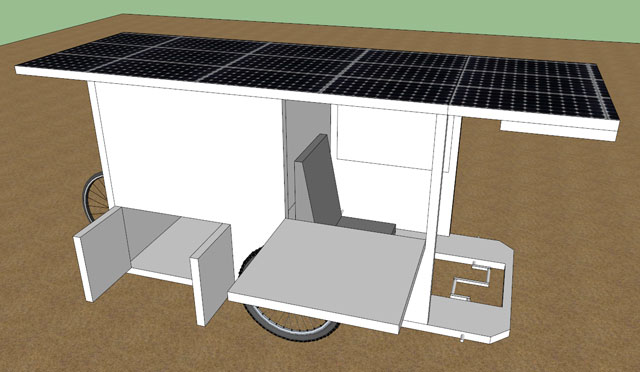
Propulsion and electrical system
The pedal axle is connected to the right wheel by a standard bicycle chain, and using standard bicycle gears that can be shifted. The two main wheels have breaks that can also be in parking mode. They are mounted on an axle that runs through the entire body, for added strength. In their hubs are electrical motors, taken from standard electric bikes. Two hub motors are used for redundancy, in case one breaks. The back wheel is used for steering, and this is done through two levers, one on each side of the seat. The levers connect to the back wheel through wires.
You sit in the seat and push the pedals while steering with the levers and shifting gears to adjust to road conditions. The hub motors aid you, and at full sunshine might even do all the work. Side mirrors help you see backwards.
The main purpose of the solar panels is to power the hub motors while riding, but they also charge a Li-Ion battery, so electrical devices can be used in the evening. Batteries are heavy and expensive, so this battery is only large enough to power simple devices, and can't run the hub motors.
Power calculations
How fast will the bike move, and can it be powered entirely by the solar panels? To know this we need to calculate the rolling resistance, the wind resistance, and the potential energy change while driving up hill.
Assumptions: the bike weighs 200 kg, the rider is 100 kg, the wind catching (front) area is 1.5 m2, and the solar panels are 3.6 m2.
A human can at most produce 350 W of power for any sustained period of time. This is equal to burning 300 kcal/hour. A 3.6 m2 standard solar panel produces around the same amount, 350 W, at full sunlight. This is not a perfect system, so some loss will occur in cables, bearings and drive chains. Lets assume 300 W is available from muscle power and 300 W is available from the solar panels. In terms of moving weights around at modest speeds (1 m/s = 3.6 km/h), we have a force of 300 N (approx 30 kg) available from both muscles and solar panels.
Rolling resistance coefficient for sturdy bicycle wheels is around 0.006, meaning that a 200 kg bike plus its 100 kg rider will require a 300 x 0.006 x 9.81 = 17.7 N force to overcome the resistance of the wheels. This force is so small that rolling resistance can be ignored.
Drag (wind resistance) is calculated by: F = 1/2 x D (air density) x V (speed) x V x A (area) x C (drag coefficient). Assuming a speed of 5 m/s, and worst possible drag coefficient, this gives: F = 1/2 x 1.2 x 5 x 5 x 1.5 x 1 = 22. 5 N, also a force so small it can be ignored. But for higher speeds it becomes an issue for sure.
So we are left with a potential energy change calculation to get a realistic value for speed. A steep slope is around 12% grade, but most inclines are far less than that. For example the road up the mountain here in Chiang Mai is on average 6% grade, with no grade exceeding 12%. For the worst case scenario of a 12% grade, the bike must be "lifted" 0.12 m for every meter it moves forward, requiring E = 300 x 9.81 x 0.12 = 353 J of energy. The speed then becomes: V = E / P = 300 / 353 = 0.85 m/s or 3.1 km/h, which is about half the speed of normal walking.
Taking real life experience into account, I know it is hard to average more than 20 km/h on a bicycle for an extended period of time, so I predict that this bike with its much heavier weight will have a normal cruising speed of 6 km/h, which is normal walking speed, and that it will be able to ascend slopes of at max 15% grade. Most of the time it will be a combination of muscle power aided by hub wheel motors, but at times solar power will be enough in itself.
How about energy cost? Leaving the solar power aside for a moment, is it more economical to use muscle power compared to having a regular engine? Looking at energy density tables we can see that gasoline (engine fuel) is 46 MJ/kg, and carbohydrates (human fuel) is 17 MJ/kg. The cost of gasoline in Thailand is $1.70/kg or 3.7 cents per MJ of energy. 1 kg of dry rice costs $1.00 and contains 0.80 kg carbohydrates, in other words $1.25/kg of carbohydrates, or 7.4 cents per MJ of energy, double the energy cost compared to gasoline. But how efficient are these systems to use the energy? About the same, around 20% efficiency for both internal combustion engines and human muscles. So in conclusion it makes no sense to use muscle power for economical reasons; it is about twice as expensive as running the same bike on gasoline. So if you are thinking that you will save money by riding a bike somewhere, you are wrong, because the cost of the additional food required will be higher than the cost of gas required. But you will arrive in really good shape, and have more fun along the way...
Water and sanitation
Water is in short supply living like this. You want the bike to be as light as possible, so this prevents you from carrying much with you, but at the same time you don't want to be dependent on finding public toilets, laundry and showers every day.
Fresh water is sourced where ever you can find it: bought from local shops, scooped from rivers or lakes, or collected from rain falling on the bike. All water is first run through a carbon filter and then a hand powered reverse osmosis filter. Water that will be used for cooking or drinking is also boiled to kill off bacteria. The water is stored in a 20 liter tank in the item compartment.
The riding seat doubles as a shower and toilet. To get privacy you close up the side and front panels. To clean yourself you use a sponge to save on water, and the gray water then runs out through the open space onto ground. To use the toilet you fold the main seat to the side which then reveals a seat ring similar to a traditional toilet. You prepare the ring with a bag made from biodegradable plastic, which catches your waste. When you are done, you tie up the bag and dispose it somewhere in nature.
Laundry is saved for when you are close to a stream or small lake. You hang up the wet clothes on a rack above the rear wheel so they dry in the wind while you're riding.
Food and cooking
Food is stocked up when ever you are close to a shop. The goal is to carry one month of supplies, so you are not too dependent on finding shops. Light items such as dried foods are preferred.
In the item compartment is a small refrigerator, with extra Styrofoam insulation. It runs its compressor when solar power is available, and relies on a phase change material to keep cool in the mean time.
Cooking is done on a small camping stove, run by alcohol, since gas containers are very heavy.
When you cook, you fold down the side panel and it becomes a table you can use for preparation and eating, as shown above.
Sleeping
To prepare for sleeping, the bike is reconfigured as shown above, and the side panels are locked from inside. You enter the bed through the front, and then pull the front panel towards you and lock it into place.
Small holes in the back panel let air in, to circulate forward and down through the hole near the riding seat. If ventilation is not enough, you can use a small electrical fan.
You sleep on an inflatable air mattress, which folds up in half when the bike is in riding mode, see above.
Safety
The bike has a horn, mainly used in traffic, but also used to scare intruders away. It can be sounded by pushing a button inside, or be triggered automatically by vibration when you are away from the bike.
The bike should be chained to a sturdy object like a tree when you are away from it.
Consider carrying a gun for worst case scenarios, hidden away in a secret compartment.
Equipment
A minimum of equipment, only necessities:
- Tools: Wrenches, knives, screwdrivers, etc.
- Repair kits, glue, tape, etc.
- Cooking: camping stove, pots, mug, cooking knife, utensils.
- Food: dried and canned food. Fresh food.
- Water. A 20 L water tank that is easily cleanable. Water filter system.
- Foldable chair.
- Clothes: Basic clothes. Nice clothes for passing cities.
- Extra insulated refrigerator.
- Medicine, including first aid.
- Valuables stash, in hidden compartment (money, passport, etc).
- Notebook computer to work on the road, with 3G internet connection.
- Telephone.
- Backpack for visits in the city.
